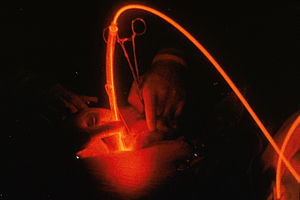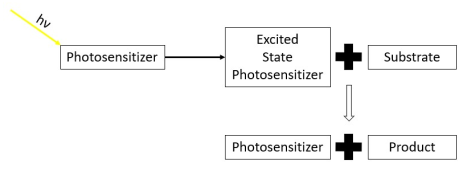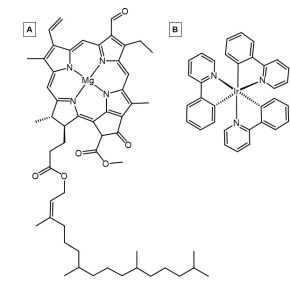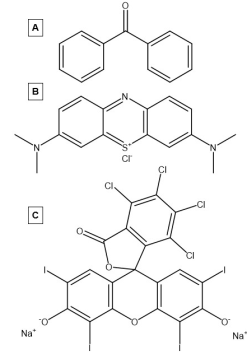Photosensitizer

Photosensitizers are light absorbers that alter the course of a photochemical reaction. They usually are catalysts.[1] They can function by many mechanisms, sometimes they donate an electron to the substrate, sometimes they abstract a hydrogen atom from the substrate. At the end of this process, the photosensitizer returns to its ground state, where it remains chemically intact, poised to absorb more light.[2][3][4] One branch of chemistry which frequently utilizes photosensitizers is polymer chemistry, using photosensitizers in reactions such as photopolymerization, photocrosslinking, and photodegradation.[5] Photosensitizers are also used to generate prolonged excited electronic states in organic molecules with uses in photocatalysis, photon upconversion and photodynamic therapy. Generally, photosensitizers absorb electromagnetic radiation consisting of infrared radiation, visible light radiation, and ultraviolet radiation and transfer absorbed energy into neighboring molecules. This absorption of light is made possible by photosensitizers' large de-localized π-systems, which lowers the energy of HOMO and LUMO orbitals to promote photoexcitation. While many photosensitizers are organic or organometallic compounds, there are also examples of using semiconductor quantum dots as photosensitizers.[6]
Theory

Mechanistic considerations
Photosensitizers absorb light (hν) and transfer the energy from the incident light into another nearby molecule either directly or by a chemical reaction. Upon absorbing photons of radiation from incident light, photosensitizers transform into an excited singlet state. The single electron in the excited singlet state then flips in its intrinsic spin state via Intersystem crossing to become an excited triplet state. Triplet states typically have longer lifetimes than excited singlets. The prolonged lifetime increases the probability of interacting with other molecules nearby. Photosensitizers experience varying levels of efficiency for intersystem crossing at different wavelengths of light based on the internal electronic structure of the molecule.[2][7]
Parameters
For a molecule to be considered a photosensitizer:
- The photosensitizer must impart a physicochemical change upon a substrate after absorbing incident light.
- Upon imparting a chemical change, the photosensitizer returns to its original chemical form.
It is important to differentiate photosensitizers from other photochemical interactions including, but not limited to, photoinitiators, photocatalysts, photoacids and photopolymerization. Photosensitizers utilize light to enact a chemical change in a substrate; after the chemical change, the photosensitizer returns to its initial state, remaining chemically unchanged from the process. Photoinitiators absorb light to become a reactive species, commonly a radical or an ion, where it then reacts with another chemical species. These photoinitiators are often completely chemically changed after their reaction. Photocatalysts accelerate chemical reactions which rely upon light. While some photosensitizers may act as photocatalysts, not all photocatalysts may act as photosensitizers. Photoacids (or photobases) are molecules which become more acidic (or basic) upon the absorption of light. Photoacids increase in acidity upon absorbing light and thermally reassociate back into their original form upon relaxing. Photoacid generators undergo an irreversible change to become an acidic species upon light absorption. Photopolymerization can occur in two ways. Photopolymerization can occur directly wherein the monomers absorb the incident light and begin polymerizing, or it can occur through a photosensitizer-mediated process where the photosensitizer absorbs the light first before transferring energy into the monomer species.[8][9]
History
Photosensitizers have existed within natural systems for as long as chlorophyll and other light sensitive molecules have been a part of plant life, but studies of photosensitizers began as early as the 1900s, where scientists observed photosensitization in biological substrates and in the treatment of cancer. Mechanistic studies related to photosensitizers began with scientists analyzing the results of chemical reactions where photosensitizers photo-oxidized molecular oxygen into peroxide species. The results were understood by calculating quantum efficiencies and fluorescent yields at varying wavelengths of light and comparing these results with the yield of reactive oxygen species. However, it was not until the 1960s that the electron donating mechanism was confirmed through various spectroscopic methods including reaction-intermediate studies and luminescence studies.[8][10][11]
The term photosensitizer does not appear in scientific literature until the 1960s. Instead, scientists would refer to photosensitizers as sensitizers used in photo-oxidation or photo-oxygenation processes. Studies during this time period involving photosensitizers utilized organic photosensitizers, consisting of aromatic hydrocarbon molecules, which could facilitate synthetic chemistry reactions. However, by the 1970s and 1980s, photosensitizers gained attraction in the scientific community for their role within biologic processes and enzymatic processes.[12][13] Currently, photosensitizers are studied for their contributions to fields such as energy harvesting, photoredox catalysis in synthetic chemistry, and cancer treatment.[11][14]

Types of photosensitization processes
There are two main pathways for photosensitized reactions.[15]
Type I
In Type I photosensitized reactions, the photosensitizer is excited by a light source into a triplet state. The excited, triplet state photosensitizer then reacts with a substrate molecule which is not molecular oxygen to both form a product and reform the photosensitizer. Type I photosensitized reactions result in the photosensitizer being quenched by a different chemical substrate than molecular oxygen.[2][16]

Type II
In Type II photosensitized reactions, the photosensitizer is excited by a light source into a triplet state. The excited photosensitizer then reacts with a ground state, triplet oxygen molecule. This excites the oxygen molecule into the singlet state, making it a reactive oxygen species. Upon excitation, the singlet oxygen molecule reacts with a substrate to form a product. Type II photosensitized reaction result in the photosensitizer being quenched by a ground state oxygen molecule which then goes on to react with a substrate to form a product.[2][17][18][19]

Composition of photosensitizers
Photosensitizers can be placed into 3 generalized domains based on their molecular structure. These three domains are organometallic photosensitizers, organic photosensitizers, and nanomaterial photosensitizers.

Organometallic

Organometallic photosensitizers contain a metal atom chelated to at least one organic ligand. The photosensitizing capacities of these molecules result from electronic interactions between the metal and ligand(s). Popular electron-rich metal centers for these complexes include Iridium, Ruthenium, and Rhodium. These metals, as well as others, are common metal centers for photosensitizers due to their highly filled d-orbitals, or high d-electron counts, to promote metal to ligand charge transfer from pi-electron accepting ligands. This interaction between the metal center and the ligand leads to a large continuum of orbitals within both the highest occupied molecular orbital (HOMO) and the lowest unoccupied molecular orbital (LUMO) which allows for excited electrons to switch multiplicities via intersystem crossing.[20]
While many organometallic photosensitizer compounds are made synthetically, there also exists naturally occurring, light-harvesting organometallic photosensitizers as well. Some relevant naturally occurring examples of organometallic photosensitizers include Chlorophyll A and Chlorophyll B.[20][21]
Organic
Organic photosensitizers are carbon-based molecules which are capable of photosensitizing. The earliest studied photosensitizers were aromatic hydrocarbons which absorbed light in the presence of oxygen to produce reactive oxygen species.[22] These organic photosensitizers are made up of highly conjugated systems which promote electron delocalization. Due to their high conjugation, these systems have a smaller gap between the highest occupied molecular orbital (HOMO) and the lowest unoccupied molecular orbital (LUMO) as well as a continuum of orbitals within the HOMO and LUMO. The smaller band gap and the continuum of orbitals in both the conduction band and the valence band allow for these materials to enter their triplet state more efficiently, making them better photosensitizers. Some notable organic photosensitizers which have been studied extensively include benzophenones, methylene blue, rose Bengal, flavins, pterins[23] and others.[24]
Quantum dots
Colloidal quantum dots are nanoscale semiconductor materials with highly tunable optical and electronic properties. Quantum dots photosensitize via the same mechanism as organometallic photosensitizers and organic photosensitizers, but their nanoscale properties allow for greater control in distinctive aspects. Some key advantages to the use of quantum dots as photosensitizers includes their small, tunable band gap which allows for efficient transitions to the triplet state, and their insolubility in many solvents which allows for easy retrieval from a synthetic reaction mixture.[18]
Nanorods
Nanorods, similar in size to quantum dots, have tunable optical and electronic properties. Based on their size and material composition, it is possible to tune the maximum absorption peak for nanorods during their synthesis. This control has led to the creation of photosensitizing nanorods.[25]
Applications
Medical
Photodynamic therapy
Photodynamic therapy utilizes Type II photosensitizers to harvest light to degrade tumors or cancerous masses. This discovery was first observed back in 1907 by Hermann von Tappeiner when he utilized eosin to treat skin tumors.[11] The photodynamic process is predominantly a noninvasive technique wherein the photosensitizers are put inside a patient so that it may accumulate on the tumor or cancer. When the photosensitizer reaches the tumor or cancer, wavelength specific light is shined on the outside of the patient's affected area. This light (preferably near infrared frequency as this allows for the penetration of the skin without acute toxicity) excites the photosensitizer's electrons into the triplet state. Upon excitation, the photosensitizer begins transferring energy to neighboring ground state triplet oxygen to generate excited singlet oxygen. The resulting excited oxygen species then selectively degrades the tumor or cancerous mass.[25][26][17]
In February 2019, medical scientists announced that iridium attached to albumin, creating a photosensitized molecule, can penetrate cancer cells and, after being irradiated with light (a process called photodynamic therapy), destroy the cancer cells.[27][28]

Energy sources
Dye sensitized solar cells
In 1972, scientists discovered that chlorophyll could absorb sunlight and transfer energy into electrochemical cells.[29] This discovery eventually led to the use of photosensitizers as sunlight-harvesting materials in solar cells, mainly through the use of photosensitizer dyes. Dye Sensitized Solar cells utilize these photosensitizer dyes to absorb photons from solar light and transfer energy rich electrons to the neighboring semiconductor material to generate electric energy output. These dyes act as dopants to semiconductor surfaces which allows for the transfer of light energy from the photosensitizer to electronic energy within the semiconductor. These photosensitizers are not limited to dyes. They may take the form of any photosensitizing structure, dependent on the semiconductor material to which they are attached.[16][14][30][31]
Hydrogen generating catalysts
Via the absorption of light, photosensitizers can utilize triplet state transfer to reduce small molecules, such as water, to generate Hydrogen gas. As of right now, photosensitizers have generated hydrogen gas by splitting water molecules at a small, laboratory scale.[32][33]
Synthetic chemistry
Photoredox chemistry
In the early 20th century, chemists observed that various aromatic hydrocarbons in the presence of oxygen could absorb wavelength specific light to generate a peroxide species.[12] This discovery of oxygen's reduction by a photosensitizer led to chemists studying photosensitizers as photoredox catalysts for their roles in the catalysis of pericyclic reactions and other reduction and oxidation reactions. Photosensitizers in synthetic chemistry allow for the manipulation of electronic transitions within molecules through an externally applied light source. These photosensitizers used in redox chemistry may be organic, organometallic, or nanomaterials depending on the physical and spectral properties required for the reaction.[16][24]
Biological effects of photosensitizers
Photosensitizers that are readily incorporated into the external tissues can increase the rate at which reactive oxygen species are generated upon exposure to UV light (such as UV-containing sunlight). Some photosensitizing agents, such as St. John's Wort, appear to increase the incidence of inflammatory skin conditions in animals and have been observed to slightly reduce the minimum tanning dose in humans.[34][35]
Some examples of photosensitizing medications (both investigatory and approved for human use) are:
See also
- Artificial photosynthesis
- Photosensitivity
- Photodynamic therapy
- Photocatalysis
- Dye-sensitized solar cell
- Photoredox catalysis
- Light harvesting materials
- Photoswitch
References
- ^ "Photosensitization". IUPAC Gold Book. International Union of Pure and Applied Chemistry. 2014. doi:10.1351/goldbook.P04652.
- ^ a b c d e f Gómez Alvarez E, Wortham H, Strekowski R, Zetzsch C, Gligorovski S (February 2012). "Atmospheric photosensitized heterogeneous and multiphase reactions: from outdoors to indoors". Environmental Science & Technology. 46 (4): 1955–63. Bibcode:2012EnST...46.1955G. doi:10.1021/es2019675. PMID 22148293.
- ^ a b Zhang Y, Lee TS, Petersen JL, Milsmann C (May 2018). "A Zirconium Photosensitizer with a Long-Lived Excited State: Mechanistic Insight into Photoinduced Single-Electron Transfer". Journal of the American Chemical Society. 140 (18): 5934–5947. Bibcode:2018JAChS.140.5934Z. doi:10.1021/jacs.8b00742. PMID 29671586.
- ^ "Photosensitization". IUPAC Compendium of Chemical Terminology. 2009. doi:10.1351/goldbook.P04652. ISBN 978-0-9678550-9-7.
- ^ Alger M (1996). Polymer science dictionary (2nd ed.). London: Chapman & Hall. ISBN 978-0412608704.
- ^ Liu Y, Ma Y, Zhao Y, Sun X, Gándara F, Furukawa H, et al. (January 2016). "Weaving of organic threads into a crystalline covalent organic framework". Science. 351 (6271): 365–9. Bibcode:2016Sci...351..365L. doi:10.1126/science.aad4011. PMID 26798010.
- ^ Gütlich P, Goodwin HA (2004). Spin crossover in transition metal compounds. Berlin: Springer. ISBN 978-3-540-40394-4. OCLC 56798940.
- ^ a b Turro NJ (1978). Modern molecular photochemistry. Menlo Park, Calif.: Benjamin/Cummings Pub. Co. ISBN 0-8053-9353-6. OCLC 4417476.
- ^ Allcock HR, Lampe FW, Mark JE (2003). Contemporary polymer chemistry (3rd ed.). Upper Saddle River, N.J.: Pearson/Prentice Hall. ISBN 0-13-065056-0. OCLC 51096012.
- ^ Kavarnos GJ, Turro NJ (1986-04-01). "Photosensitization by reversible electron transfer: theories, experimental evidence, and examples". Chemical Reviews. 86 (2): 401–449. doi:10.1021/cr00072a005. ISSN 0009-2665.
- ^ a b c Daniell MD, Hill JS (May 1991). "A history of photodynamic therapy". The Australian and New Zealand Journal of Surgery. 61 (5): 340–8. doi:10.1111/j.1445-2197.1991.tb00230.x. PMID 2025186.
- ^ a b Gollnick K (1968). "Type II Photooxygenation Reactions in Solution". Advances in Photochemistry. Vol. 6. John Wiley & Sons, Ltd. pp. 1–122. doi:10.1002/9780470133361.ch1. ISBN 978-0-470-13336-1.
- ^ Julliard M, Chanon M (1983-08-01). "Photoelectron-transfer catalysis: its connections with thermal and electrochemical analogs". Chemical Reviews. 83 (4): 425–506. doi:10.1021/cr00056a003. ISSN 0009-2665.
- ^ a b O'Regan B, Grätzel M (October 1991). "A low-cost, high-efficiency solar cell based on dye-sensitized colloidal TiO 2 films". Nature. 353 (6346): 737–740. Bibcode:1991Natur.353..737O. doi:10.1038/353737a0. ISSN 1476-4687. S2CID 4340159.
- ^ Baptista, Mauricio S.; et al. (2017). "Type I and Type II Photosensitized Oxidation Reactions: Guidelines and Mechanistic Pathways". Photochemistry and Photobiology. 93 (4): 912–919. doi:10.1111/php.12716. hdl:11336/64008. PMID 28084040.
- ^ a b c Sang X, Li J, Zhang L, Wang Z, Chen W, Zhu Z, et al. (May 2014). "A novel carboxyethyltin functionalized sandwich-type germanotungstate: synthesis, crystal structure, photosensitivity, and application in dye-sensitized solar cells". ACS Applied Materials & Interfaces. 6 (10): 7876–84. doi:10.1021/am501192f. PMID 24758570.
- ^ a b Karimi M, Sahandi Zangabad P, Baghaee-Ravari S, Ghazadeh M, Mirshekari H, Hamblin MR (April 2017). "Smart Nanostructures for Cargo Delivery: Uncaging and Activating by Light". Journal of the American Chemical Society. 139 (13): 4584–4610. Bibcode:2017JAChS.139.4584K. doi:10.1021/jacs.6b08313. PMC 5475407. PMID 28192672.
- ^ a b Jiang Y, Weiss EA (September 2020). "Colloidal Quantum Dots as Photocatalysts for Triplet Excited State Reactions of Organic Molecules". Journal of the American Chemical Society. 142 (36): 15219–15229. Bibcode:2020JAChS.14215219J. doi:10.1021/jacs.0c07421. PMID 32810396. S2CID 221179722.
- ^ a b Devika, Sivakumar; Rakhi, Raju; Y.T., Kamal; Shahana, Salam (3 January 2023). Porphyrinoid Photosensitizers for Targeted and Precise Photodynamic Therapy: Progress in Fabrication. London: intechopen. pp. 145–174. ISBN 978-1-83768-471-7.
- ^ a b Zhang Y, Lee TS, Petersen JL, Milsmann C (May 2018). "A Zirconium Photosensitizer with a Long-Lived Excited State: Mechanistic Insight into Photoinduced Single-Electron Transfer". Journal of the American Chemical Society. 140 (18): 5934–5947. Bibcode:2018JAChS.140.5934Z. doi:10.1021/jacs.8b00742. PMID 29671586.
- ^ Prier CK, Rankic DA, MacMillan DW (July 2013). "Visible light photoredox catalysis with transition metal complexes: applications in organic synthesis". Chemical Reviews. 113 (7): 5322–63. doi:10.1021/cr300503r. PMC 4028850. PMID 23509883.
- ^ Bowen EJ (1963). "The Photochemistry of Aromatic Hydrocarbon Solutions". Advances in Photochemistry. Vol. 1. John Wiley & Sons, Ltd. pp. 23–42. doi:10.1002/9780470133316.ch2. ISBN 978-0-470-13331-6.
- ^ Lorente, Carolina; et al. (2021). "A model to understand type I oxidations of biomolecules photosensitized by pterins". Journal of Photochemistry and Photobiology. 7: 100045. doi:10.1016/j.jpap.2021.100045. hdl:11336/171897.
- ^ a b Romero NA, Nicewicz DA (September 2016). "Organic Photoredox Catalysis". Chemical Reviews. 116 (17): 10075–166. doi:10.1021/acs.chemrev.6b00057. PMID 27285582.
- ^ a b Jang B, Park JY, Tung CH, Kim IH, Choi Y (February 2011). "Gold nanorod-photosensitizer complex for near-infrared fluorescence imaging and photodynamic/photothermal therapy in vivo". ACS Nano. 5 (2): 1086–94. doi:10.1021/nn102722z. PMID 21244012.
- ^ Morlière P, Mazière JC, Santus R, Smith CD, Prinsep MR, Stobbe CC, et al. (August 1998). "Tolyporphin: a natural product from cyanobacteria with potent photosensitizing activity against tumor cells in vitro and in vivo". Cancer Research. 58 (16): 3571–8. PMID 9721863.
- ^ University of Warwick (3 February 2019). "Simply shining light on dinosaur metal compound kills cancer cells". EurekAlert!. Retrieved 3 February 2019.
- ^ Zhang P, Huang H, Banerjee S, Clarkson GJ, Ge C, Imberti C, Sadler PJ (February 2019). "Nucleus-Targeted Organoiridium-Albumin Conjugate for Photodynamic Cancer Therapy". Angewandte Chemie. 58 (8): 2350–2354. doi:10.1002/anie.201813002. PMC 6468315. PMID 30552796.
- ^ Tributsch H (1972). "Reaction of Excited Chlorophyll Molecules at Electrodes and in Photosynthesis". Photochemistry and Photobiology. 16 (4): 261–269. doi:10.1111/j.1751-1097.1972.tb06297.x. ISSN 1751-1097. S2CID 94054808.
- ^ Teodor AH, Bruce BD (December 2020). "Putting Photosystem I to Work: Truly Green Energy". Trends in Biotechnology. 38 (12): 1329–1342. doi:10.1016/j.tibtech.2020.04.004. PMID 32448469.
- ^ Zeng W, Cao Y, Bai Y, Wang Y, Shi Y, Zhang M, et al. (2010-03-09). "Efficient Dye-Sensitized Solar Cells with an Organic Photosensitizer Featuring Orderly Conjugated Ethylenedioxythiophene and Dithienosilole Blocks". Chemistry of Materials. 22 (5): 1915–1925. doi:10.1021/cm9036988. ISSN 0897-4756.
- ^ McCullough BJ, Neyhouse BJ, Schrage BR, Reed DT, Osinski AJ, Ziegler CJ, White TA (March 2018). "Visible-Light-Driven Photosystems Using Heteroleptic Cu(I) Photosensitizers and Rh(III) Catalysts To Produce H2". Inorganic Chemistry. 57 (5): 2865–2875. doi:10.1021/acs.inorgchem.7b03273. PMID 29446925.
- ^ Zhou Q, Shi G (March 2016). "Conducting Polymer-Based Catalysts". Journal of the American Chemical Society. 138 (9): 2868–76. Bibcode:2016JAChS.138.2868Z. doi:10.1021/jacs.5b12474. PMID 26863332.
- ^ Kumper H. [Hypericum poisoning in sheep]. Tierarztl Prax 1989;17:257-261.
- ^ a b Brockmoller J, et al. Hypericin and pseudohypericin: Pharmacokinetics and effects on photosensitivity in humans. Pharmacopsychiatry 1997;30(Suppl 2): 94-101.
- ^ Vignoni, Mariana; Rasse-Suriani, Federico A. O.; Butzbach, Kathrin; Erra-Balsells, Rosa; Epe, Bernd; Cabrerizo, Franco M. (2013-07-24). "Mechanisms of DNA damage by photoexcited 9-methyl-β-carbolines". Organic & Biomolecular Chemistry. 11 (32): 5300–5309. doi:10.1039/C3OB40344K. hdl:11336/2178. ISSN 1477-0539. PMID 23842892.
- ^ a b c "Medications and other Agents that Increase Sensitivity to Light". Wisconsin Department of Health Services. 2013-07-11. Retrieved 2022-11-01.
